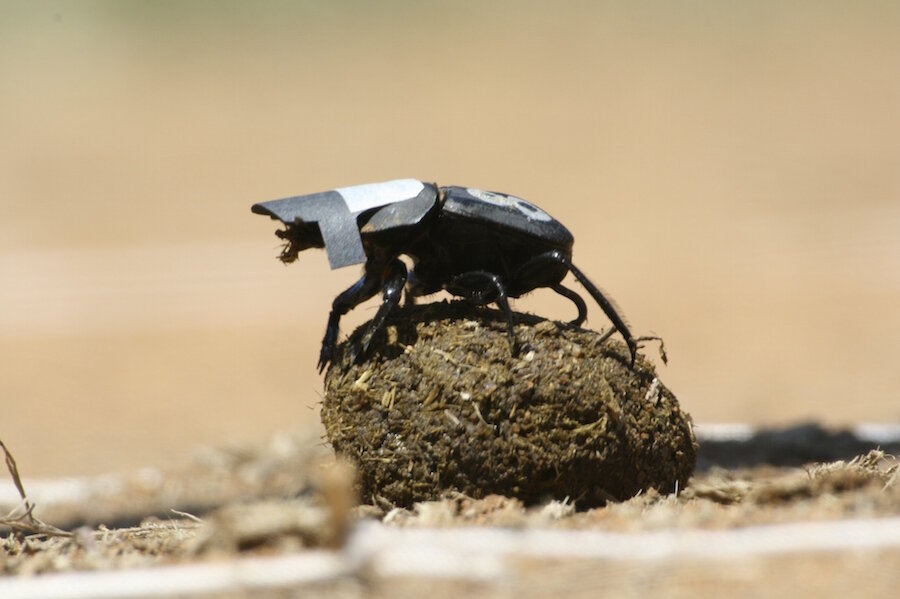Why we have dinosaurs to thank for today's dung beetles
Loading...
The evolution of dung beetles may have involved animals that scientists hadn't expected: dinosaurs.
A new study suggests dinosaurs and dung beetles may be more linked than we knew. The study was conducted by a team of international scientists exploring the potential of how dinosaurs might be associated with the early evolution of dung beetles.
The results, published Wednesday in the scientific journal PLOS ONE, push back the timeline for when dung beetles originated by roughly 30 million years and, possibly, help settle a debate that has divided scientists for decades.
"Historically, a lot of scientists have presumed that because the majority of today's dung beetle feed on mammal dung, they must have evolved with mammals," Lead author of the study Nicole Gunter of the Cleveland Museum of Natural History, said in a phone interview with The Christian Science Monitor.
An opposing group had suspected that dung beetles were far older, but with no molecular data to support their point, the two hypotheses over the origin of the dung beetle have competed for decades.
Dr. Gunter originally wasn't involved in the debate. She was focused on exploring whether or not beetles that did not directly depend on plants to survive were boosted by the rise of angiosperms, or flowering plants.
Scarab beetles, the family of beetles to which dung beetles belong, provided a perfect subject for Gunter's study. The family is essentially split down one line – half of scarab beetles are plant-eaters and the other half subsist on materials like dung. Seeing whether the dung beetles got a boost from angiosperm evolution would be identifiable by comparing them to their herbivore cousins.
To that end, the DNA of 125 scarab beetles were sequenced at the Australian National Insect Collection for the study and the analyses were combined with the previously published beetle DNA sequences to make a representative study of 450 beetles.
And the results of the sequencing became the first molecular evidence to link the evolution of an insect to dinosaurs, Gunter says.
The DNA of dung beetles in the sample revealed they were far too old to have evolved alongside mammals. The DNA placed dung beetles at an origination date roughly 30 million years earlier than previously suspected, somewhere between 130 million to 115 million years ago in the lower cretaceous period.
"Even though there were mammals during the cretaceous, they were very, very small and all insectivores," says Gunter. The resulting dung from mammals of that time period would have been too small to support dung beetles.
But dinosaurs, the predominant terrestrial animals at the time, would have produced plenty of dung for the beetles to survive on. And interestingly, Gunter's findings suggest that the rise of angiosperms likely made dinosaur dung edible for the beetles for the first time around the Cretaceous period – supporting her original hypothesis.
The new evidence is in line with other research on the topic. There are dinosaur coprolites (fossilized dinosaur dung) from 70 million to 80 million years ago that featured tunneling that some scientists attributed to dung beetles.
And it also helped fill in some of the remaining unknown aspects of dung beetle evolution. Such as, if dung beetles were so dependent on dinosaurs, how did they survive their extinction?
The evidence suggests "there probably was an extinction event that also occurred within the dung beetles," says Gunter. "We would have never have known this because there isn't a very good fossil record of dung beetles that exists."
The results can likely be seen in modern species numbers – there is one plant-feeding beetle group about the same age as dung beetles that has 18,000 species in that family. There are only 5,000 species of dung beetles.
The scientific evidence is not definitive and with 5,0000 dung beetles species there is still a lot of research to explore, but Gunter was confident her findings poked holes in the idea that dung beetles evolved alongside mammals.
"When there's more fossil evidence for the dung beetle we'll have more data to readdress the question ... but with the evidence we have today, I think there is good support for our results," says Gunter.








